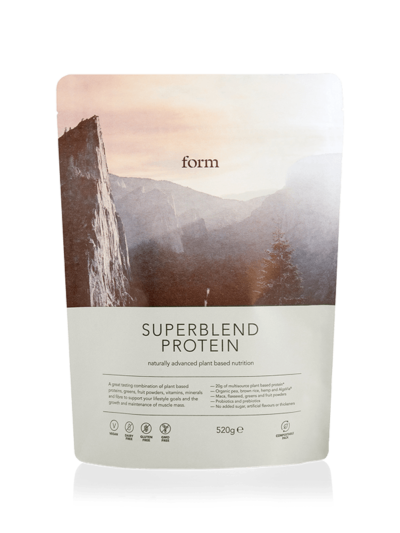Ask Dr. Adam: Is Spot Reduction a Myth?

Want toned arms, abs, or lean legs? You’re not alone. The desire to change specific areas of the body, often tied to the persistent spot reduction myth, is widespread. But is this goal actually achievable?
According to Form’s Head of Nutrition, Dr. Adam Collins, the spot reduction myth is just that: a myth. “You can strengthen and grow muscle in a specific area, but you can’t choose where your body burns fat,” he explains. “Your body decides that, based on factors far beyond your control.”
In this article, Dr. Adam debunks the science behind spot reduction, outlines what does work for fat loss, and shares strategies to help you reach your goals without falling for fitness fads.
Why Spot Reduction Is So Appealing
From ab workouts promising a six-pack in six weeks to arm-toning routines for “Pilates arms”, fitness culture is filled with misleading claims. Many of these ideas are amplified by viral trends, influencer content, and algorithm-driven workout advice.
The truth? “There’s no shortcut to fat loss in a specific body part,” says Dr. Adam. “It’s a physiological process governed by your hormones, genetics, and overall energy balance.”
What Determines Where You Store Fat?
We all store body fat, but the where and how much is not random. It’s largely influenced by four key factors: gender, hormones, age, and genetics.
1. Gender
Women naturally carry more body fat than men, around 25 to 30 percent versus 15 to 20 percent, to support pregnancy and breastfeeding. But fat distribution also differs: men tend to store fat around the abdomen (apple-shaped or android pattern), while women store more in the hips, thighs, and buttocks (pear-shaped or gynoid pattern).
Women typically distribute fat more evenly across the body. In contrast, men often accumulate excess fat in a more centralised pattern, particularly around the waist and abdominal area.
2. Hormones
Hormones play a central role in how fat is stored and distributed. Oestrogen is a major factor in the gynoid fat pattern seen in women. It encourages fat storage in the lower body and helps regulate energy balance.
In men, androgens like testosterone contribute to abdominal fat storage. Another key hormone is cortisol, a stress hormone released via activation of the Hypothalamic-Pituitary-Adrenal (HPA) axis. Cortisol, particularly when chronically elevated, is linked to fat accumulation in the upper body and around the waist. Combined with higher testosterone levels, this can lead to increased visceral fat, the fat stored deep around internal organs. This type of fat is especially harmful and has strong links to metabolic and cardiovascular risk.
Insulin also influences fat storage. When combined with elevated cortisol levels, common in high-stress lifestyles, it can promote fat retention in central regions.
3. Age
As we age, fat levels tend to increase due to gradual declines in energy expenditure, changes in hormone levels, and shifts in lifestyle. In women, menopause plays a significant role. The drop in oestrogen not only increases the likelihood of weight gain but also shifts fat distribution toward the abdomen, a pattern more commonly seen in men.
“This creates a more male-pattern fat distribution and levels the playing field when it comes to health risks,” says Dr. Adam.
Men also experience hormonal changes with age, such as reduced testosterone, which contributes to further fat accumulation around the waist. In both sexes, ageing increases the risk of storing visceral fat, the type associated with higher long-term health risks.
4. Genetics
Your genes play a significant role in determining where and how you store fat. Research suggests that genetics may account for approximately 60 percent of the variation in fat distribution between individuals. [1]
Genome-wide association studies (GWAS) have identified numerous genetic loci linked to specific fat storage patterns. [2] These findings help explain why fat distribution varies so much between individuals, even when body weight is similar.
Ethnic background further influences fat storage. For example, South Asian populations typically have lower levels of subcutaneous fat (the type found just under the skin) and a greater tendency to store visceral fat, the deeper, more metabolically active fat linked to increased health risks. [3] Conversely, individuals of African or Caribbean descent may have different fat distribution profiles despite having similar overall fat levels. [4]
All of this reinforces the point that fat storage is not solely dictated by diet or lifestyle. Your genetic blueprint and ancestry play a meaningful role in shaping your body’s fat patterns and associated health risks.
How Fat Loss Actually Works
Losing body fat, regardless of whether it’s around your waist, thighs, or arms, requires your body to enter a state known as net lipolysis. This means your fat cells are breaking down more fat than they’re storing.
“Your fat cells are constantly shifting between storing and releasing fat,” explains Dr. Adam. “To lose fat, you need to tip the balance toward breakdown, and that only happens with a consistent calorie deficit.”
A calorie deficit occurs when you consume fewer calories than you burn. Initially, your body may draw on stored glycogen or muscle energy, but after a few hours of sustained deficit, it turns to fat reserves for fuel. This is how meaningful fat loss happens over time.
“Whether you cut calories through diet, increase your physical activity, or combine both, the deficit is non-negotiable,” says Dr. Adam. “It’s the foundation of any successful fat loss strategy.”
Not All Weight Loss Is Equal
In the early stages of weight loss, your body sheds water and glycogen, but around 50 percent of the weight lost is fat. As the calorie deficit continues, that percentage typically increases to 70 to 80 percent.
Importantly, visceral fat, the fat stored around your organs, is often the first to go. Even before you see visible changes, fat inside organs such as the liver begins to shrink. A modest 5 percent reduction in body weight can improve blood sugar control, reduce triglycerides and cholesterol, and lower cardiovascular risk.
“Fat around the abdomen often decreases before fat from the arms or legs,” adds Dr. Adam. “The so-called ‘stubborn’ fat is usually subcutaneous and slower to shift, but it’s also less harmful.”

What About Low-Carb and High-Protein Diets?
You might have heard that low-carb diets accelerate fat loss by reducing insulin and forcing your body to burn fat. While there’s some logic to this, since insulin does promote fat storage, research shows that when calories are controlled, low-carb diets do not outperform low-fat diets in terms of body fat loss. In fact, low-fat diets may even prove to be more effective in certain cases.
“People often lose more weight on low-carb diets simply because they eat fewer calories without realising it,” says Dr. Adam. “But it’s still the calorie deficit doing the work, not the absence of carbs.”
High-protein diets are often recommended during fat loss phases, and for good reason. Protein helps preserve lean muscle mass and increases satiety, which can make it easier to stick to a reduced-calorie diet. However, it’s not a shortcut.
“Protein is helpful, especially when paired with resistance training,” says Dr. Adam. “It supports muscle retention, but it won’t make you lose more fat unless you’re still in a deficit.”
Learn more about how much protein you should be eating.
Can You Target Fat Loss in Specific Areas?
The idea that you can burn fat from a specific body part, like doing crunches to lose belly fat, is one of the most persistent myths in fitness.
“You can strengthen muscles in a specific area, but that won’t necessarily reduce the fat covering them,” says Dr. Adam. “Everyone has a six-pack. You just need to lose the fat covering it to see it.”
Some studies have explored whether exercising a specific muscle group can lead to regional fat loss. These typically involve targeted resistance exercises followed by cardio to burn off released fat. But the evidence is weak and results are inconsistent.
“The studies that exist tend to be small and not particularly rigorous,” says Dr. Adam. “You might see improved tone or strength, but the fat loss still happens on a whole-body level.”
The Shivering Theory: A Glimpse Into Future Research
Some emerging research on shivering and cold exposure offers intriguing insights. Shivering stimulates the release of myokines, proteins from muscle, that signal fat cells to burn energy, a process known as non-shivering thermogenesis. This turns white fat into more metabolically active brown or beige fat.
“Shivering releases proteins called myokines, which signal fat cells to start burning fat for heat,” explains Dr. Adam. “Interestingly, some of the same myokines are also released during exercise.”
Because your body needs to dissipate heat during endurance workouts, fat breakdown may occur more readily near active muscle groups. While not true spot reduction, this mechanism might explain why fat loss sometimes appears more pronounced in areas being trained.
Smarter Toning Strategies That Actually Work
While spot reduction is a myth, you can absolutely work toward a leaner, more defined physique by focusing on overall fat loss and muscle retention. Dr. Adam recommends:
- Create a calorie deficit through a combination of diet and exercise
- Prioritise protein to preserve lean muscle
- Incorporate resistance training to build shape and strength
- Use cardio or endurance training to support fat burning
- Try time-restricted eating or reduce snacking to improve fat mobilisation
- Be patient: “The fat you care about most often takes the longest to shift,” says Dr. Adam, “but it will go.”
- Avoid drastic solutions like liposuction, which may alter appearance but not metabolic health
Final Word from Dr. Adam
Not all fat is created equal. Visceral fat is the most metabolically harmful, but also the most responsive to lifestyle changes. Fat on the hips and thighs? It’s slower to shift, but often protective, especially for women.
“No supplement or shortcut can override your body’s basic energy balance,” says Dr. Adam. “Fat loss happens when your body draws from its energy reserves to meet a shortfall. That means burning stored fat.”
“Instead of chasing quick fixes or spot-reduction myths,” he adds, “focus on sustainable habits. Be consistent, train smart, eat well, and give it time. Your body will lose fat where it needs to most, and it will thank you for it.”
So the next time you come across a fat-burning tea or 10-day toning challenge, remember, science says otherwise.
Read more: NHS – Why visceral fat matters
References
- Pulit, S.L. et al. (2019). Meta-analysis of genome-wide association studies for body fat distribution in 694,649 individuals of European ancestry. Nature Genetics, 51(9), 1225–1233.
- Shungin, D. et al. (2015). New genetic loci link adipose and insulin biology to body fat distribution. Nature, 518(7538), 187–196.
- Kirk, A. et al. (2022). Ethnic differences in body fat distribution and liver fat between South Asians and white Europeans. Diabetologia, 65, 157–167.
- Speakman, J.R. et al. (2021). GWAS for body fat distribution: Lessons from ethnicity and evolution. Genes, 12(6), 841.



















